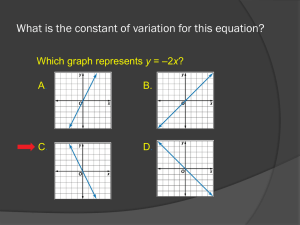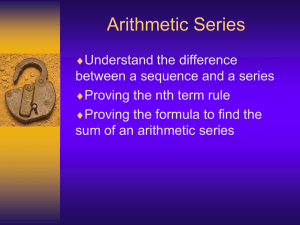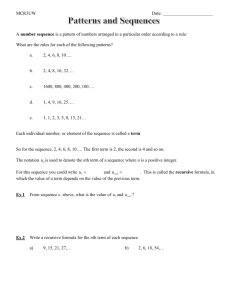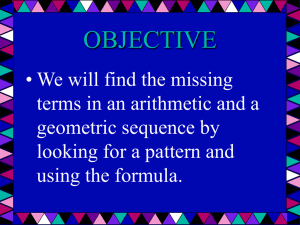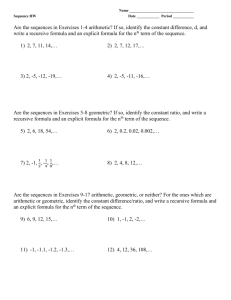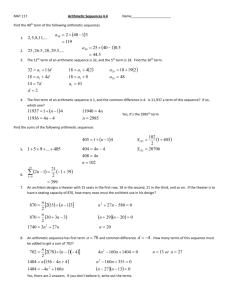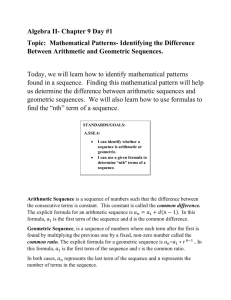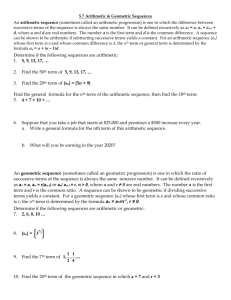Arithmetic Sequences: Linear Functions Lesson Notes
advertisement
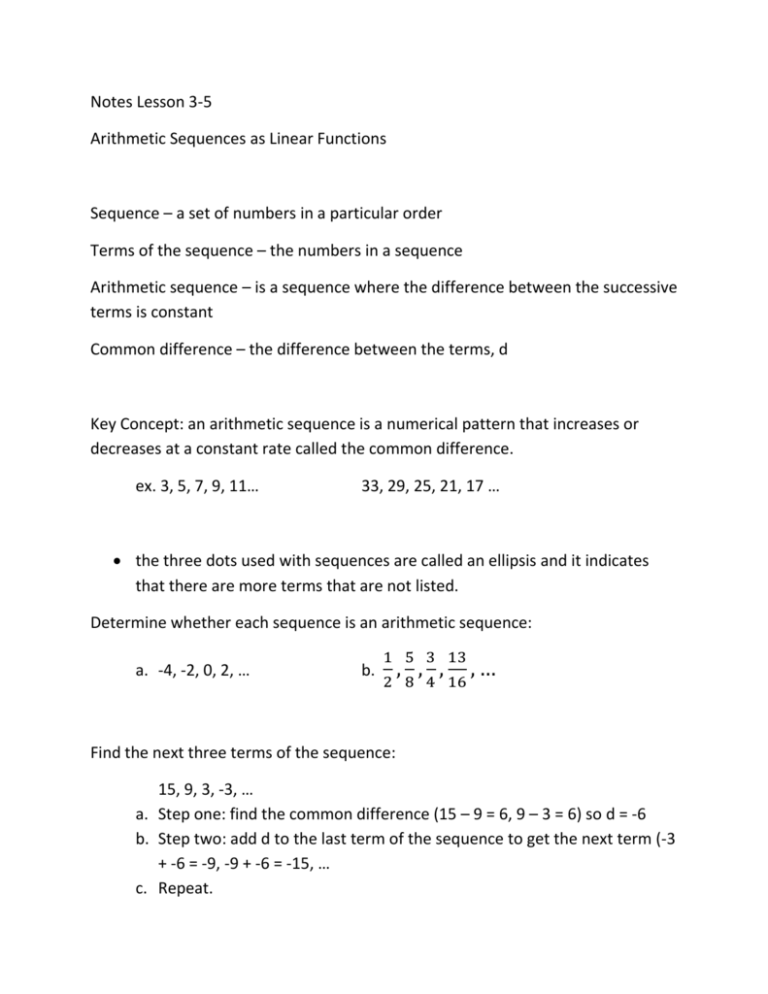
Notes Lesson 3-5
Arithmetic Sequences as Linear Functions
Sequence – a set of numbers in a particular order
Terms of the sequence – the numbers in a sequence
Arithmetic sequence – is a sequence where the difference between the successive
terms is constant
Common difference – the difference between the terms, d
Key Concept: an arithmetic sequence is a numerical pattern that increases or
decreases at a constant rate called the common difference.
ex. 3, 5, 7, 9, 11…
33, 29, 25, 21, 17 …
the three dots used with sequences are called an ellipsis and it indicates
that there are more terms that are not listed.
Determine whether each sequence is an arithmetic sequence:
a. -4, -2, 0, 2, …
b.
1 5 3 13
, , ,
2 8 4 16
,…
Find the next three terms of the sequence:
15, 9, 3, -3, …
a. Step one: find the common difference (15 – 9 = 6, 9 – 3 = 6) so d = -6
b. Step two: add d to the last term of the sequence to get the next term (-3
+ -6 = -9, -9 + -6 = -15, …
c. Repeat.
Find the next four terms of the arithmetic sequence: 9.5, 11.0, 12.5, 14.0…
Each term in an arithmetic sequence can be expressed in
terms of the first term, a₁, and the common difference, d.
Term
Symbol
In terms of a₁
and d
Numbers
First term
Second term
Third term
Fourth term
a₁
a₂
a₃
a₄
a₁
a1 + d
a₁ + 2d
a₁ + 3d
8
8 + (3)= 11
8 + 2(3) = 14
8 + 3(3) = 17
nth term
an
a₁ + (n-1)d
8 + (n-1)(3)
Example: Find the nth term
a. Write an equation for the nth term of the arithmetic sequence
-12, -8, -4, 0, …
Step 1: find the common difference
-12 -8 -4
0
+4 +4 +4
Step 2: Write an equation:
an = a1 + (n-1)d
= -12 + (n-1) 4
= -12 + 4n – 4
= 4n – 16
b. Find the 9th term of the sequence
Substitute 9 for n in the formula
an = 4n – 16
a9 = 4(9) – 16
a9 = 36 – 16
a9 = 20
c. Graph the first 5 terms of the sequence
n
4n – 16
1
4(1) – 16
2
4(2) - 16
3
4(3) – 16
4
4(4) – 16
5
4(5) - 16
an
-12
-8
-4
0
4
d. Which term of the sequence is 32?
In the formula for the term, substitute 32 for an.
an = 4n – 16
32 = 4n – 16
+16
+16
48 = 4n
12 = n
(n, an)
(1, -12)
(2, -8)
(3, -4)
(4, 0)
(5, 4)
Try this one: Consider the arithmetic sequence: 3, -10, -23, -36….
a.
b.
c.
d.
Write an equation for the nth term in the sequence
Find the 15th term in the sequence
Graph the first five terms
Which term in the sequence is -114?
Arithmetic Sequences as Functions
Example: Marisol is mailing invitations to her quinceanera. The arithmetic
sequence $0.42, $0.84, $1.26, $ 1.68, … represents the cost of postage.
a. Write a function to represent this sequence
The first term a1 is $0.42. Find the common difference
0.42 0.84 1.26 1.68
+0.42 +0.42 +0.42
The common difference is 0.42.
an = a1 + (n-1)d
= 0.42 + (n-1)(0.42)
= 0.42 + 0.42n – 0.42
= 0.42n
The function is f(n) = 0.42n
b. Graph the function and determine the domain
The rate of change is 0.42. Make a table and plot some points.
n
f(n)
1
0.42
2
0.84
3
1.26
4
1.68
5
2.10
The domain of the function is the number of invitations Marisol mails.
So the domain is {1, 2, 3, 4, …}
the set of natural numbers, N


